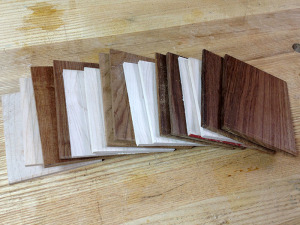What Do You Do With Your Tenon Cheeks?
Probably the best method I know for fixing a loose tenon is to glue the cheek back in place. This is one of the nice things about hand sawing tenons: you don’t turn your waste material into saw dust. Instead you have a small piece of stock left over that is very useful. Because of this I have gotten into the habit of keeping my sawn cheeks around during a build. A little paring or planing to flatten the faces and you and fatten up a tenon quickly for a tight fit, or start over again and saw it agin. Fortunately, as my sawing has improved over the years, I do less and less fixing and usually some light paring is the only adjustment I need to fit my mortise and tenon joints. The habit remains still and I usually end up with a stack of tenon cheeks once I’m finished with my joinery. What to do with this stock?
 Sometimes I keep it and throw it in a drawer where I go for wedge or shim material. Hand Tool School members have often referred to this as my “magic drawer” as it seems I always have a near perfect piece in there just when I need it. It is always a massive time saver when I don’t have to cut down a larger board when I’m looking for a 1/4″ wedge for a tenon. Grab a piece close to your finished size and pare in a wedge shape with a chisel.
Sometimes I keep it and throw it in a drawer where I go for wedge or shim material. Hand Tool School members have often referred to this as my “magic drawer” as it seems I always have a near perfect piece in there just when I need it. It is always a massive time saver when I don’t have to cut down a larger board when I’m looking for a 1/4″ wedge for a tenon. Grab a piece close to your finished size and pare in a wedge shape with a chisel.
Sometimes I use this stock to make pegs. Just rive out a strip from the tenon cheek and pound it through a dowel plate and you have a peg in seconds. You also can thread that peg and you have a useful item for shop made tools like marking gauges.
I just finished cutting and fitting 12 mortise and tenon joints on my latest pole lathe and I’m left with this deck of cards of Maple and Teak. Anybody have some useful things they do with leftover tenon cheeks? Please leave a comment below and share it.



